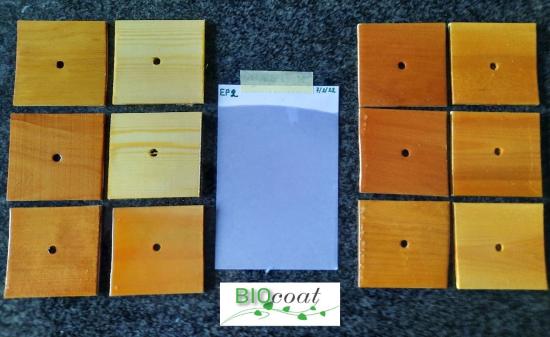Epoxy resins are still a first-choice polymer for applications in adhesives, composites and protective coatings on wood, concrete or stone because of the good balance in mechanical properties and long-term protection. Their use, however, is somewhat limited due to some drawbacks in intrinsic properties and because of environmental reasons, there is in parallel an increasing demand for bio-based alternatives. To enhance the introduction of bio-based epoxy coatings, R&D in this field has strongly expanded in recent years. In this context, Sirris has made a screening study of different types commercially available bio-epoxy coatings. This study was recently published.
For indoor use in flooring or furniture, epoxy resins offer a high hardness and abrasion resistance. For outdoor use, they offer resistance against fungal decay, mild corrosion protection and chemical resistance, while their resistance against UV radiation is inferior. However, lifetime of epoxy coatings needs to be further increased, together with a better scratch resistance and water repellence. In general, the mechanical resistance of epoxy coatings increases with higher crosslink density and increasing glass transition temperature. However, the brittleness and poor impact resistance may limit their use in tribological applications. In parallel, coating industry is increasingly committed to enhance sustainability and reduce footprint of binder materials by making the transition towards bio-based coating compositions.
Bio-based epoxy coatings
The formulations of epoxy coatings with enhanced performance and incorporation of bio-renewable resources can be adapted and optimised towards given end-properties through thoughtful selection of an epoxy resin in combination with suitable crosslinkers (hardeners) and diluents. As such, the screening and gradual replacement of each component in the epoxy formulation allow to tune the performance of the coating and increase the bio-based content.
The different bio-based epoxy components might be based on vegetable oils, lignin, tannins, rosin, saccharides, terpenes or side-products from seed processing. However, a direct one-by-one replacement of the traditional fossil-based coating compositions towards bio-based coatings cannot directly be made as it would often -not result in the most wanted performance. Therefore, the re-engineering of the coating formulations is a better approach while the influence of processing conditions has to be better understood and optimised. In parallel, the stepwise increase in bio-based content for an epoxy coating should allow to reduce coating compositions with toxic bisphenol A.
Commercial grades of bio-based epoxy resins claim about 22 to 52 % of biobased content depending on the epoxy system and supplier. The re-design of bio-based coatings should be considered, in order to fully exploit the potential of increased bio-based content in agreement with better performance. For the latter, it means that better monitoring of the curing process as a function of the coating composition is necessary and becomes a critical step in the development of new coating compositions. In particular, the evaluation of curing kinetics through thermal analysis should allow coating formulators for optimising the composition and application procedures while enhancing the coating performance.
New study on curing and performance
In a study by Sirris, which was recently published, a screening was made for different types of commercially available bio-epoxy coatings, with either the epoxy resin derived from glycerol or the hardener derived from phenalkamine. The bio-based phenalkamine curing agents are synthesised from cardanol oil, which is recovered as a by-product in the distillate from cashew nutshell liquid (CNSL). These epoxy hardeners have specific characteristics compared to traditional petroleum-based curing agents, such as e.g., extremely fast cure, low temperature cure (even below 0 °C), good chemical resistance, good surface appearance, good moisture tolerance, and non-blushing properties. Also due to the long aliphatic side chain of cardanol, phenalkamines also have very good pot life, good flexibility, surface tolerance, and better water and salt water resistance. The aromatic phenol group within PK results in a crosslinked epoxy network with high rigidity, thermal stability, and chemical resistance, while the presence of an aliphatic sidechain provides flexibility, hydrophobicity, viscosity control, and wettability. The residual hydroxyl groups on the phenol structure aid in superior adhesion to various substrates. In our studies, different suppliers of phenalkamines have been contacted to incorporate their products with a variety in chemistry and properties.
The curing of epoxy coatings with traditional fossil-based amines versus a novel category of bio-based phenalkamines was evaluated, in order to illustrate the performance and detect optimised processing conditions for bio-based curing agents. The curing process for the latter can be better controlled and results in coatings with higher hardness and better mechanical resistance. The high ductility and impact resistance of bio-based epoxy coatings is beneficial for the increased wear resistance and higher lifetime. This behaviour can mainly be explained in terms of the intrinsic mechanical properties of fossil-based versus bio-based epoxy coatings. Although the chemical structures of both coatings are different, good control on the degree of crosslinking is a main parameter to correlate coating performance.
The coatings have been further evaluated as protective coating on wood substrates for furniture and decorative paper for enhancing hydrophobic protection, transparency and durability. At present, further steps are undertaken for tuning the epoxy coating properties depending on the incorporation of functional additives from residual biomass. The full study has been published in MDPI Molecules (2023) and is now available for download.
Committed to support in bio-based coating applications
The study, performed at Sirris, has been undertaken during the COOCK project BioCoat, in which demonstration cases with model formulations for bio-based acrylates, epoxy and polyurethane coatings have been developed. The aim of this study is guiding companies in their search for alternative bio-based binders of traditional coatings and assisting them in the implementation of novel coating formulations. As part of the goals of the COOCK project, generalised knowledge is disseminated through networking events, workshops and publications with detailed presentation of the results. In future, Sirris remains committed to support companies in the implementation of bio-based coatings with enhanced functionality. Therefore, we remain involved in projects on increasing bio-based content and functionality of coatings for various applications.





